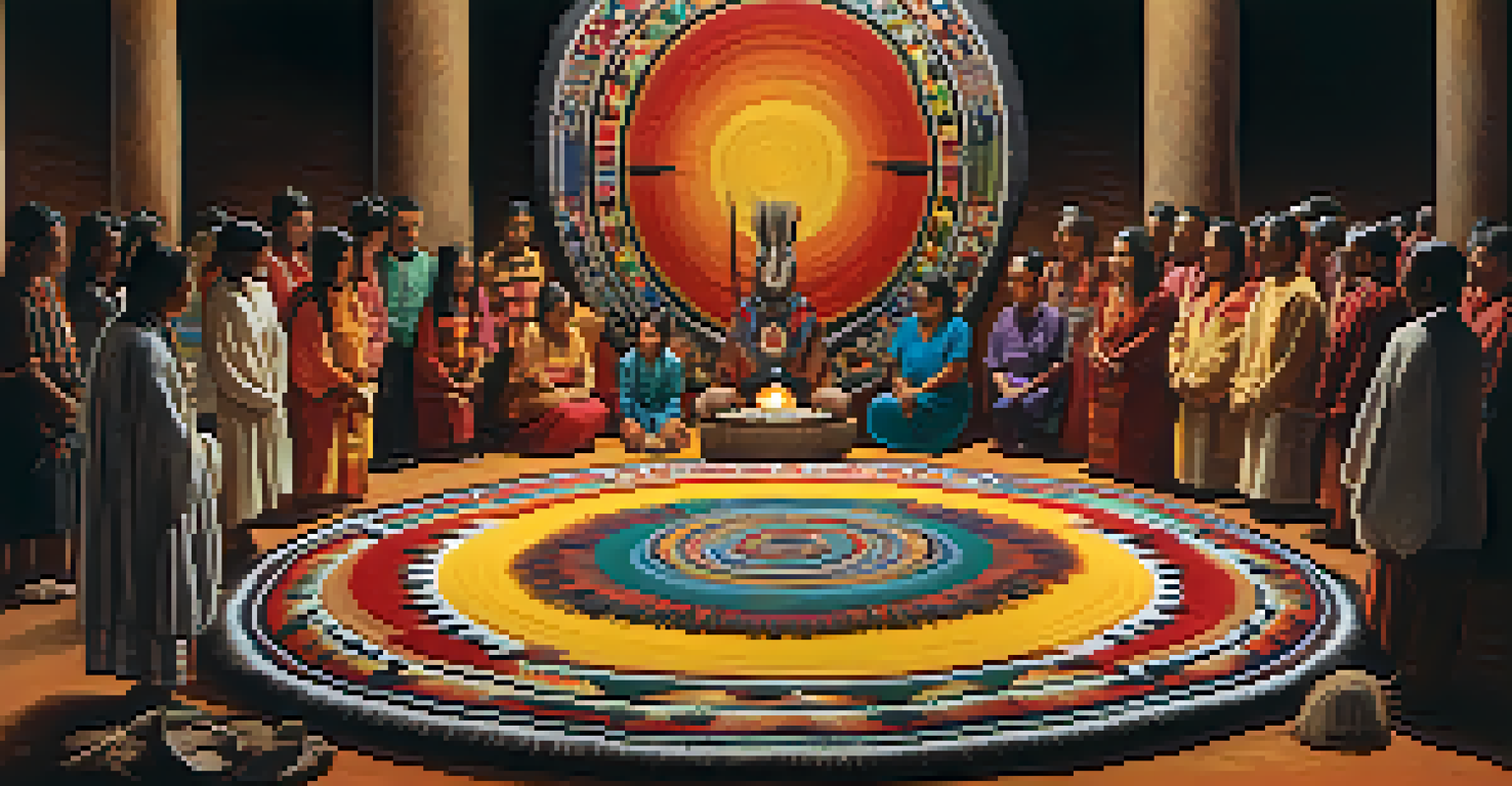Cultural Context of Peyote Use in Personal Meaning Search

Peyote: A Brief Overview of Its Cultural Significance
Peyote, a small cactus native to Mexico and the southwestern United States, has been used for centuries by Indigenous peoples for its psychoactive properties. It contains mescaline, a compound that induces altered states of consciousness, which many believe facilitate deeper understanding of oneself and the universe. This cultural significance is rooted in various spiritual practices, where peyote is often seen as a conduit for connecting with the divine.
The use of peyote is not merely a search for personal insight; it is a deeply rooted cultural practice that connects us to our ancestors and the environment around us.
Indigenous groups, such as the Huichol and the Navajo, incorporate peyote into rituals and ceremonies, emphasizing its role in healing, vision quests, and communal bonding. These practices highlight the cactus's importance not only as a spiritual tool but also as a symbol of cultural identity and heritage. The use of peyote in these contexts reflects a profound respect for nature and a belief in the interconnectedness of all life.
As modern society continues to explore alternative forms of spirituality and self-discovery, peyote's cultural legacy remains relevant. People are drawn to its historical roots and the insights it promises, leading to a resurgence of interest in Indigenous practices surrounding this sacred plant.
The Role of Peyote in Personal Meaning Search
For many individuals, the search for personal meaning can feel like navigating a vast ocean without a map. Peyote, with its unique psychoactive effects, offers a potential beacon for those seeking clarity and purpose. Users often report profound experiences that help them confront personal challenges, gain insights, and foster a sense of belonging.

The journey with peyote is often described as a transformative experience, allowing individuals to delve into their subconscious and confront unresolved emotions. This process can lead to catharsis, healing, and a renewed sense of direction. Many participants share stories of newfound clarity and understanding after engaging with peyote, underscoring its impact on personal growth.
Cultural Importance of Peyote
Peyote has been a vital spiritual tool for Indigenous peoples, symbolizing cultural identity and connection to the divine.
It's important to note, however, that this journey is deeply personal and varies widely among individuals. What resonates as meaningful for one person may not hold the same weight for another, highlighting the subjective nature of personal meaning and the diverse paths individuals take in their quest for self-understanding.
Historical Context of Peyote Use in Indigenous Cultures
The historical use of peyote dates back thousands of years, particularly among Indigenous cultures in North America. These communities have employed peyote in ceremonial practices to connect with spiritual realms, seek guidance, and establish a communal identity. This rich history is a testament to the plant's enduring significance in the cultural fabric of these societies.
In a world where many seek meaning, the wisdom of the past can guide us towards understanding our place within the larger tapestry of life.
Rituals involving peyote often include music, dance, and storytelling, which serve to reinforce communal bonds and pass down cultural heritage. The collective experience of ingesting peyote during these ceremonies emphasizes the importance of shared spiritual exploration, fostering a sense of unity among participants. In this way, peyote acts as a cultural touchstone that transcends individual experiences.
As colonization and modernization threatened these traditions, many Indigenous groups have worked tirelessly to preserve their practices involving peyote. This resilience speaks to the profound connection these communities have with the plant and the cultural identity it represents, highlighting the ongoing relevance of peyote in contemporary Indigenous spirituality.
Modern Interpretations of Peyote Use
In recent years, there has been a growing interest in peyote beyond Indigenous circles, prompting discussions about its therapeutic potential. Researchers and mental health professionals are exploring the use of peyote in treating various psychological conditions, such as PTSD and depression. This modern interpretation often intersects with traditional practices, raising important questions about cultural appropriation and respect for Indigenous knowledge.
Many individuals who seek out peyote for personal growth may approach it with a sense of reverence, acknowledging its cultural roots. This mindfulness can shape the way they experience the plant, creating a bridge between traditional and contemporary uses. However, it is crucial to engage with these practices ethically and respectfully, ensuring that Indigenous voices are heard in conversations surrounding peyote.
Personal Transformation Through Peyote
Many individuals report profound personal insights and healing experiences derived from peyote, highlighting its potential for personal growth.
As society shifts towards a more holistic understanding of mental health, peyote's role is evolving. This intersection of ancient wisdom and modern science invites a deeper conversation about the ways in which we seek meaning in our lives and the importance of honoring the traditions that have paved the way for these explorations.
Challenges Facing Peyote and Its Cultural Practitioners
Despite its significance, peyote faces numerous challenges today, particularly due to overharvesting and habitat loss. As demand for the cactus grows, many Indigenous communities are concerned about the sustainability of this sacred plant. The delicate balance between preserving peyote for spiritual practices and meeting external demand poses a significant threat to its future.
Additionally, the legal status of peyote varies widely, creating barriers for those who wish to engage in traditional practices. While some states in the U.S. allow its use for religious purposes, others do not, leading to confusion and potential legal repercussions for practitioners. This inconsistency complicates the landscape for those seeking to connect with peyote in a meaningful way.
These challenges underscore the importance of advocacy for Indigenous rights and sustainable practices. Supporting initiatives that promote the conservation of peyote and respect for Indigenous cultures can help ensure that this powerful plant continues to play a vital role in personal meaning searches for generations to come.
Personal Stories of Transformation Through Peyote
Personal narratives often illuminate the profound impact peyote can have on individuals. Many who have engaged with peyote recount experiences that have reshaped their understanding of themselves and the world around them. These stories serve as powerful testimonials to the potential of peyote as a tool for personal transformation and insight.
For example, a young woman shared her journey of healing from trauma through a peyote ceremony, describing how the experience allowed her to confront her fears and emerge with a renewed sense of self. Such stories highlight the deeply personal nature of these experiences, as well as the variety of insights individuals can gain from their interactions with peyote.
Challenges in Peyote Preservation
Peyote faces significant threats from overharvesting and legal inconsistencies, raising concerns about its sustainability and cultural practices.
These accounts not only celebrate the transformative power of peyote but also encourage others to explore their own paths towards meaning and healing. By sharing their stories, individuals contribute to a growing narrative that underscores the significance of peyote in personal journeys and the importance of community support in these explorations.
Finding Balance: Respecting Tradition and Personal Exploration
As interest in peyote grows, it becomes increasingly important to find a balance between personal exploration and respect for Indigenous traditions. Engaging with peyote should be approached with mindfulness, acknowledging its cultural significance and the wisdom of those who have used it for centuries. This respect can help foster a more ethical relationship with the plant and its traditional uses.
Individuals interested in peyote should seek to educate themselves about its cultural context, aiming to honor the practices of Indigenous communities. This could involve participating in workshops or seeking guidance from knowledgeable practitioners. By approaching peyote with humility and reverence, individuals can enrich their own experiences while supporting the preservation of Indigenous traditions.

Ultimately, the journey of personal meaning search through peyote can be a shared one, connecting people from diverse backgrounds. By fostering mutual respect and understanding, we can ensure that peyote continues to serve as a source of insight and healing for all who seek it, while upholding the cultural integrity of its traditional uses.